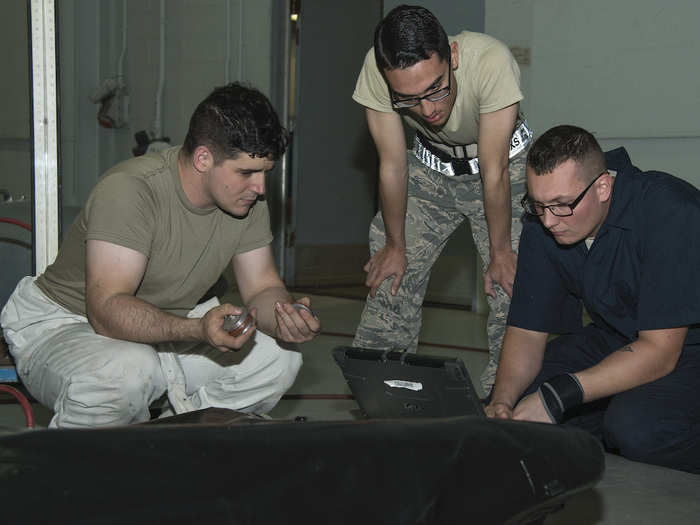
Airmen remove the bladder from a hole not much bigger than a shoebox, pump it up with air pressure and then test with either a chemical or bubble solution to uncover any impairment.


Before climbing into the aircraft fuels cell, the Tank Divers don personal protective equipment such as coveralls, head covers, gloves and air respirators to avoid harm from the chemicals they encounter.
"The process of opening a fuel tank is very dangerous and can present an explosive environment," said Williamson. "People don't really get to see much of what we do or where we go because when we open that tank up, we can't have anything that produces a spark or is not intrinsically safe [nearby]. Our hangar is set up to be 100% safe and fireproof."

"Since we're considered a back shop, we also go out to our alternate location on the opposite end of the flightline," said Williamson. "To mitigate going back and forth, our team here designed a trailer that would house everything we need to be out on a job and take shelter from the elements."


Through strength and flexibility, MacDill's Tank Divers maintain the hearts of all 24 KC-135s assigned here, ensuring the blood is pumping right for every mission, day-and-night.
 I quit McKinsey after 1.5 years. I was making over $200k but my mental health was shattered.
I quit McKinsey after 1.5 years. I was making over $200k but my mental health was shattered. Some Tesla factory workers realized they were laid off when security scanned their badges and sent them back on shuttles, sources say
Some Tesla factory workers realized they were laid off when security scanned their badges and sent them back on shuttles, sources say I tutor the children of some of Dubai's richest people. One of them paid me $3,000 to do his homework.
I tutor the children of some of Dubai's richest people. One of them paid me $3,000 to do his homework. Move over Bollywood, audio shows are starting to enter the coveted ‘100 Crores Club’
Move over Bollywood, audio shows are starting to enter the coveted ‘100 Crores Club’
 10 Powerful foods for lowering bad cholesterol
10 Powerful foods for lowering bad cholesterol
 Eat Well, live well: 10 Potassium-rich foods to maintain healthy blood pressure
Eat Well, live well: 10 Potassium-rich foods to maintain healthy blood pressure

Copyright © 2024. Times Internet Limited. All rights reserved.For reprint rights. Times Syndication Service.